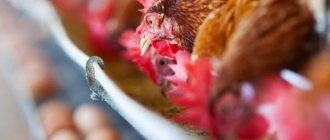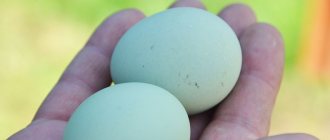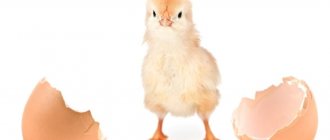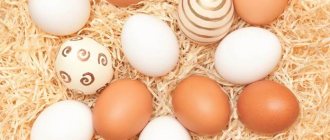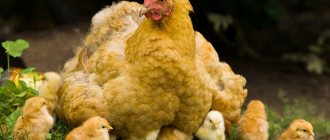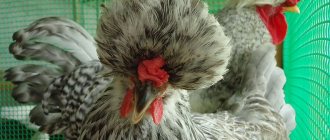All about eggs
- Fact 1:
The very first eggs that a laying hen begins to produce may be small in size and consist only of protein. - Fact 2:
On average, it takes 20-25 hours to ripen a full-fledged egg (yolk, white, shell), provided the bird is well cared for - Fact 3:
Sometimes a chicken lays an egg in a thin, leathery membrane, without a hard shell. - Fact 4:
When laying hens live in a poultry house without a rooster, they lay unfertilized eggs. Such products are considered dietary.
All life on Earth reproduces. Mammals give birth to their young, trees produce new shoots, flowers produce seeds, fish spawn, birds lay eggs. Nature has created completely different ways of bringing new inhabitants into the world, and each of them is surprising and mysterious. At least for ordinary people who are far from science. But I really want to lift this veil of secrecy and plunge into the mysterious world of the birth of new lives.
And for some it is simply necessary. For example, poultry farmers, who are responsible for the production of healthy bird offspring or simply complete, nutritious egg products. But really, how do chickens lay eggs? Where do they come from, why is not every one suitable for raising chicks, why are some considered dietary and others not? How many questions should a novice farmer find answers to before he takes control of a chicken population?
What does the chicken reproductive system consist of?
Scheme:
Ovaries
The fundamental elements of a chicken’s reproductive system are two ovaries and an oviduct, located in a small part of its pelvis. Only the left ovary is fully involved in the reproduction process. The right one adapts by the time the bird matures.
Cells are formed in the ovary - egg primordia or oocytes, from which the yolk is subsequently formed.
Oocytes are covered with a shell of layers of epithelial and connective tissue. In the complex, the rudiments and the membrane make up the follicles, which are suspended in the form of a “bunch of grapes” on the ovary.
Oviduct
The ovary with follicles is located above the opening in the expanded funnel of the oviduct. It consists of a thick-walled, tortuous fallopian (uterine) tube. The funnel is attached to the abdominal wall by muscle ligaments, which ensure its mobility during follicle maturation.
The entire oviduct is divided into several sections:
- top pipe with hole and funnel;
- protein part of the pipe;
- isthmus;
- a wide area of the uterus with the vagina.
Next, the tube connects through the large intestine to the cloaca of the chicken.
The total length of the pipe, depending on the size of the bird, is 35-85 centimeters. The length of the protein part is up to 37 centimeters. The diameter of the pipe is 7-8 centimeters. The diameter of the funnel hole is 7-9 centimeters.
What happens when a chicken's egg matures?
When the egg matures, the membrane of the vesicle bursts, and the mature egg falls out of it and enters the oviduct. This is where fertilization occurs. Regardless of whether the egg was fertilized or not, it still remains inside the bird for some time, matures, becomes shelled, and only after 23-26 hours comes out. The excretory tracts of the reproductive organs, as well as the ureters and intestines, in chickens open into the cloaca. Eggs usually emerge from the oviduct with the blunt end first.
Fertilization
About the rooster
Physiologically, the rooster lacks an organ that penetrates the hen's body. The male reproductive system consists of two symmetrically located testes, two vas deferens, which enter the cloaca through small thickenings (seminal vesicles).
Where do sperm come from, read the article “Structure of the reproductive system of a rooster.”
How is everything going?
Fertilization occurs when the cloaca of a male and female come into contact. After sexual intercourse, sperm reach the fallopian tubes. If there is an egg in them, fertilization occurs. After mating, the seminal fluid retains its properties in the chicken’s tubes for 20 days.
Sometimes it turns out that the rooster, despite his efforts, cannot fertilize the female. Find out about the reasons for this phenomenon in the article “How roosters impregnate hens.”
Do you need a male?
Sometimes a chicken's eggs are unfertilized for another reason. A natural feature of laying hens is that the reproductive organs independently form the yolk, white and eggshell, facilitating their development without an embryo.
The only drawback is that it is impossible to get offspring from such an egg.
It is believed that without a rooster, a hen experiences less stress and lays more eggs than in his presence. To find out if this is true, read the article “Can hens lay eggs without a rooster?”
Do you need a rooster to produce eggs?
Beginning farmers are often interested in whether poultry can lay eggs without a rooster. A chicken produces an egg in any case, and this does not depend on the presence of a rooster in the chicken coop. However, in this case, the eggs appear unfertilized, and the chick will not be able to hatch from them.
How does a chicken form an egg if there is no rooster in the house? The egg first passes through the bird's reproductive organs. During this, it becomes overgrown with a shell and a protein shell. Then a normal testicle, without an embryo, begins to emerge from the hen.
Important! If there is not a single rooster in the coop, the chickens will not become pregnant, and because of this they will not have offspring.
How do chickens lay eggs?
Formation of yolk and white
Now let's figure out where the testicles inside a chicken come from, and how many of them there can be.
A chicken ovary contains up to 4 thousand fertile cells. All follicles are in different stages of maturation.
A mature oocyte breaks the walls of the follicle, is tightly grasped by numerous processes on the infundibulum and penetrates from the surface of the ovary into the lumen of the tube. The size of the yolk at the beginning of the movement is 40 millimeters.
Moving through the protein part of the fallopian tube, a cord appears at the yolk. It connects the yolk to the mucous membrane of the tube. The oocyte is covered with a deep layer of protein produced in the tissues of the walls.
Shell formation
Next, the embryo enters the isthmus in front of the uterus. The isthmus contains glands that produce enzymes. From them, the under-shell layers are formed: the inner one - the covering protein, and the outer one.
At this stage the hen needs sufficient calcium. As a result, eggs may end up with stronger shells.
From the isthmus, the testicle enters the uterus, where it is saturated with uterine fluid and increases to the size of a full-fledged egg. The uterus, producing a special enzyme, completes the formation of the shell shell.
Birth
Later, through the sphincter (muscle ring), the testicle enters the vagina. The uterus descends, the walls of the vagina turn out and push it out.
When the formed egg has passed through the cloaca, it is ready for incubation. Of course, if it is fertilized. The article “Determination of fertilized chicken eggs by ovoscoping” will help determine this fact.
0.5 hours after the egg is laid, the next mature cell leaves the follicle (ovulation) and moves through the tube.
Useful properties of eggs
The chicken egg is an indispensable product on our table; it is present in
daily diet of almost every person. Historians say that people have been happily eating eggs for about several thousand years. The composition of these amazing chicken products is unique in that it contains 12 main vitamins - from A to K, and in terms of vitamin D content, egg yolk cannot compete except with the healthiest fish oil.
Eggs also contain iron, iodine, calcium, phosphorus, potassium, magnesium, copper, cobalt, boron, sulfur, and manganese, which are vital for the human body. Eggs can strengthen the immune system, improve the functioning of the cardiovascular system, reduce the likelihood of the formation of cancer cells, normalize the gastrointestinal tract, have a beneficial effect on vision, strengthen bone tissue, promote the proper construction of muscle tissue, and strengthen the nervous system.
They bring tangible benefits to pregnant and lactating women, as they contain folic acid, which is very necessary for them during this wonderful period of life. Eggs are also indispensable in the diet of men, as they can significantly improve the quality of sperm and contribute to the conception of a child. They should also be included in the daily diet of athletes and all those who engage in physical labor and also struggle with excess weight.
Regardless of how old a person is, if he regularly eats chicken eggs, he can significantly improve the condition of his hair, teeth and nails. Thus, no matter how old you are, be sure to eat chicken eggs in any form. The only contraindication to this may be a tendency to be allergic to these types of products, as well as limiting their quantity if you suffer from diabetes, gastrointestinal or liver diseases.
Is it painful for chickens to lay eggs?
The walls of the fallopian tube consist of numerous folds covered with ciliated epithelium. The main part of the wall thickness is the muscular layer with layers of connective tissue.
With intensive and prolonged laying, the tube lengthens 10 times due to the folds, and the walls of the uterus expand in diameter to match the size of the testicle.
Small cilia on the walls push the testicle to move along the tube. In combination with the mucous coating, a sliding effect is created. Therefore, the chicken lays an egg without pain.
The only problem is if the chicken comes out with an egg that is too large. In this case, cracks appear on the surface of the cloaca, and when contaminated, inflammation occurs (cloacitis). How to get rid of this disease is described in the article “Diseases of the cloaca in chickens.”
By the way, the expression “the hen gives birth to the egg” is incorrect. Since you can only give birth to a baby (fetus), and not eggs.
Do you need a rooster for a chicken to lay eggs?
It is important to understand that a chicken can lay eggs without a rooster. Industrial enterprises obtain table (unfertilized) eggs from egg breeds of chickens. They are obtained without the use of roosters. They are not fertilized, and it is impossible to get chicks from store-bought eggs. They are used only for food. At egg production enterprises, hens are raised and roosters are culled.
Therefore, if you only have chickens on your private farm, they will lay ordinary table eggs, and you cannot get offspring from them. To get a hatching egg, you need to have a rooster in the herd along with the hens, then they will be fertilized.
How to identify a chicken with good productivity
Chickens of the egg production direction have good egg production; when choosing poultry for egg production, it is better to use breeds of the desired productivity direction. The bird is judged on its exterior qualities. Birds have a large body mass, strong bones, smooth plumage, and well-formed wings. When palpated, laying hens have a large, soft belly. The chicken's behavior is active, the chickens graze well, and they look healthy in appearance. The Leghorn breed is considered the best egg breed. Egg production 240 eggs. The record was set in 71 of the 20th century and was 371 eggs.
What does a chicken egg consist of?
The composition is complex, it must contain everything necessary so that the embryo receives the necessary components for growth and development. In a fertilized egg, a germinal disc is visible on the surface of the yolk. It is an oval white spot - 4 mm in diameter. The egg contains protein 55-57%, yolk 30-32%, shell 10-12%, chemical composition water is 74%, dry matter 27%, fats 12%, proteins 13%, carbohydrates 11%, also included contains lysocine, an enzyme that keeps eggs fresh.
What affects the duration of egg formation?
The time it takes for an egg to form varies depending on the breed of chicken, the season and the conditions under which it is kept.
The germ moves along the protein section of the tube for 3-4 hours, then enters the isthmus of the fallopian tube. The egg stays there for about an hour.
From the isthmus it enters the uterus, where it develops for 19 hours or more. The formed testicle is pushed out by the uterus, quickly moving through the vagina and colon.
On average, the time it takes for an egg to form from the moment the cell matures is 20-25 hours.
How to increase the productivity of laying hens
Attempts to change the rate of egg formation in order to increase the productivity of laying hens have been made by many scientists and poultry farming practitioners. All these attempts were associated mainly with changes in the length of the astronomical day and daylight hours for laying birds or with targeted selection of chickens.
By selecting chickens based on the duration of egg formation in several generations, scientists were able to breed laying hens in which the time to form eggs decreased by an average of 4 hours: from 27.6 to 23.6 g. Thanks to this, the productivity of chickens increased by 5-6% compared to with a group of unselected chickens.
Numerous experiments with reducing the astronomical day to 16, 14 and 12 hours have not yet given practically significant results for the production of eggs on poultry farms and poultry factories. An increase in the duration of the astronomical day (up to 26-30 hours) with different periods of light and darkness leads to a slight increase (up to 10%) in the mass of the testicle.
As the astronomical day increases to 27 hours, an improvement in the quality of the shell is also observed, its thickness and strength increase. Science now faces the task of developing and applying light regimes that would correspond to the physiological state of the laying hen and its biological clock. This should ensure not only a sharp increase in the egg production of chickens, but also in the quality of the eggs.
Possible problems
A young laying hen produces eggs consisting only of protein. The reason is that protein clots appear in the oviduct, which are enveloped in the shell. This is a natural process that does not affect the condition of the chicken.
In case of stress, hormonal imbalance, or some viral infections, blood clots may appear in the yolk. The solution to the problem is to keep the bird healthy.
Oocytes develop in the follicle at different intervals. Typically, one oocyte matures inside a chicken per day. If two rudiments ripen simultaneously in a day, then at the end of the process eggs with two yolks are released.
Is it possible to raise a chicken without a rooster?
The answer is simple - without it, the laying hen will not be able to hatch chickens. It is necessary for the fertilization of eggs. For summer residents, the absence of a rooster in the poultry house is quite reasonable and understandable. ... A laying hen cannot fertilize them without a male.
Interesting materials:
Thuja is drying up, how to save it? 54 Federal Law who is exempt from the use of CCP? Advent what is it? Agroperlite what is it and what is it for? When is an advance invoice issued? Bard liquid what is it? Business self-service car wash, how much cost is required? Blanching what is it? Where is boric acid used? Brand what is it?
Why doesn't a chicken lay eggs every day?
The frequency of laying depends on how long the embryo develops in the uterus of the tube. If the egg is formed in less than 24 hours, then the hen lays them every day.
As a rule, ovulation occurs in the first half of the day. When the egg is formed for more than a day, the hen will lay eggs intermittently the next day at 10:00, 12:00 or 14:00 hours. The longer the egg develops, the fewer eggs the laying hen will produce in a row.
Chickens of egg-laying breeds can lay eggs almost daily. Chickens of meat and egg breeds lay eggs every other day, meat breeds lay eggs once every 2-3 days.
Egg production of chickens by cycles
It is also interesting that the quality of eggs depends on the length of the cycle.
With short cycles, egg weight decreases faster than with long cycles (8-10 days). Eggs laid early in the cycle are larger.
As we already know, the formation of the shell takes up to 21 hours, but its formation occurs most intensively during the first 16 hours of the egg’s stay in the uterus.
If these hours occur during daylight hours, then the quality of the shell is higher. This is explained by the fact that laying hens absorb calcium better during the day. Here, it turns out, are the subtleties you need to know in order to get a full-fledged egg in a chicken. Therefore, it is necessary to “adjust” the light and feeding regimes to the physiological rhythm of the laying hen and not disturb them unnecessarily.
The natural rhythm that has developed over centuries determines the time of egg laying. Chickens usually lay eggs in the morning, only some of them do it during the day.
However, eggs laid during the day are larger than eggs laid in the morning, their shells are of higher quality, and the yolk is more intensely colored. At the same time, irregularly shaped and double-yolk eggs are more common among them.
How to increase the quantity? eggs produced
Some farmers are faced with the fact that, with proper care of the chickens, the productivity of their eggs is insufficient.
There are several useful recommendations that will help solve this problem:
- Maintain the correct temperature in the poultry house - the room must be insulated, negative temperatures reduce egg production. Walk the birds periodically and equip them with comfortable nests.
- It is recommended to provide additional lighting in the chicken coop , for example, fluorescent light bulbs. Short daylight hours negatively affect the performance of hens.
- Carefully monitor the length of daylight hours - it should not last more than 14 hours, otherwise the chicken will not have time to gain strength.
- Keep air humidity at approximately 60-70%. Only with such indicators will the chicken feel comfortable.
- productivity . Per 1 square meter, house from four to six laying hens - too dense a concentration can adversely affect the number of eggs.
- Feed your birds properly and in a balanced manner. Be sure to include wet mash into your diet; limiting yourself to just grain and dry food is not recommended. Avoid overfeeding or underfeeding.
- Add a variety of mineral supplements to your diet , which can easily be purchased at a pet store. Introduce premixes and compound feeds.
- Chickens love kitchen scraps: fish entrails, ground bones and even meat scraps. Treat your birds to this variety of food from time to time.
When a hen molts, she stops laying eggs for a while. Some bird owners achieve early molting by creating stressful situations for the chicken. The owners keep the birds on a hunger strike and give only water, then the animal begins to moult. After this, you can resume your diet by adding vitamins and minerals that are beneficial to the body. The molt ends faster, the animal begins to rush.
Causes of problems with egg laying
There are cases when chickens lay half-boiled small eggs (with dense whites) or stop laying altogether. The main causes of problems with egg laying:
- Changing your diet. Some farmers dramatically change the diet for poultry, which negatively affects their egg production. It is important that the new food is similar in composition to the previous one. It should contain a sufficient amount of calcium and vitamins.
- Unsuitable conditions of detention. To keep chickens, you need to choose the most suitable place indoors. The daylight hours of poultry should last at least 12 hours, so it is recommended to equip the chicken coop with additional lighting lamps. You also need to make sure that the temperature inside does not drop below 15 degrees Celsius. If the chickens have not laid a single egg during their entire stay in the coop, it may be too cold.
- Development of diseases. Sometimes stopping egg laying indicates that the hen is sick. Other symptoms may indicate the development of the disease, which include lethargy, loss of appetite and sudden weight loss.
- Shedding. The stoppage of egg production may coincide with seasonal molting, when the laying hens begin to shed their feathers. Most often this happens in mid or late autumn. In this case, there is no need to do anything, since egg laying will restore itself.
Problems with egg production in chickens
Features of egg laying of chickens of different breeds
Leghorn
In many ways, it depends on the breed how many eggs a chicken can lay. There are several types of breeds: egg, meat-egg and meat.
Representatives of the first two breeds have the highest performance indicators. Meat chickens are raised for slaughter and subsequent sale of meat.
- Russian white. The young grow quickly; with proper care, the bird begins to produce eggs from 4 months. A laying hen of the Russian White breed can produce up to 240 eggs per year, the weight of one egg is up to 60 grams.
- Leghorn. The most popular breed in Russia. Characterized by high performance, easy acclimatization. The shell is white. A laying hen produces up to 300 eggs weighing up to 65 grams per year.
- Loman Brown. The eggs of the breed are brown. Productivity per year is up to 320 eggs, product weight is up to 64 grams.
- Highsex white. The color of the shell is light, as is the plumage of the individual. Produces up to 315 eggs per year, maximum weight - 64 grams.
- High Line. One of the most productive breeds, produces white eggs. A laying hen produces up to 350 eggs weighing up to 65 grams per year.
Black eggs in chickens
Probably, many are accustomed to the fact that the color of birds’ eggs is mostly light. But a chicken that lays black eggs still surprises even the most experienced poultry farmers. There is a decorative breed of chickens called Ayam Tsemani - it is completely black, from head to paws. The breed is distinguished by the fact that it has not only dark plumage, but skin and even eggs. Even their blood is dark, as is their meat and all their organs. The reason is a genetic trait – fibromelanosis.
Egg without shell
If a young hen lays small eggs or products consisting only of protein, this is completely natural. Poultry farmers define such eggs as fat eggs - they are formed when a protein clot appears in the oviduct, enveloped by a shell.
But what to do if an adult hen produces eggs in film, without shells? Most often, this occurs due to a lack of elements in the laying hen’s body that are essential for life: calcium and phosphorus.
Disorders can occur due to stress and during a viral infection. To ensure that the eggs are strong and healthy, that there are no bloody spots in them, and that the shell does not break before the time necessary for the formation of high-quality products, do not allow disturbances in the hormonal system of domestic chickens.
Provide your birds with the right diet, plenty of space, and care for them carefully.
Composition and quality of eggs
A standard, full-fledged egg weighs approximately 60 g and contains:
- from 70 to 75% water;
- 13% protein;
- 11% fat;
- 0.7% carbohydrates.
At the same time, the nutritional value of light (white) and dark (red) is the same. They differ only in that:
- the first are laid by light-colored chickens, and the second by birds with dark plumage;
- white eggs are usually smaller;
- dark ones have a denser and stronger shell, so they last longer and withstand transportation better.
It has been noticed that homemade eggs have an orange yolk, while factory eggs are paler. It's all about carotene. Feed at a poultry farm includes various components, of which there are more than 50. The proportion of carotene in such diets may be more or less. Poultry in the summer receive this element in abundance, with fresh grass, which is why the yolk is orange. However, this color does not affect the taste of the egg at all, but only makes it more beautiful in cross-section.
Common problems
Beginners often encounter maintenance difficulties. What to do if a bird pecks an egg? Usually the disease affects one individual, but after a while the entire chicken coop becomes involved in sabotage.
If there are no errors in the housing conditions, then the reason must be sought in the regular feeding of eggshells to the livestock. Laying hens get used to the smell and sight of the product, so they use it as the main source of calcium. Once you try the white and yolk at least once, it will be difficult to stop you from committing a “crime.”
In crowded conditions, an aggressive female may appear that likes to feed on the protein mass of the nest. Many chickens follow their fellow tribesmen and adopt dangerous habits. It is recommended to observe the herd for a while and identify the culprit. Such an individual hangs around near places where birds were flying.
Knowing the characteristics of chicken reproduction, you can get the most out of a small flock. You learned how a complex process works and what needs to be done to avoid making common mistakes. The data will be useful to both beginners and experienced farmers.
Leader in the chicken coop
There is no need to minimize the role of the feathered gentleman, because the rooster can become a real invaluable assistant. He gives a wake-up call early in the morning and, like a good owner, creates approximate order in the chicken coop. Young individuals behave more calmly, chickens do not fight and defend their right to primacy. They have spurs on their ankles that can cut the skin. The rooster monitors the safety of all his subordinates and can drive away a stray dog or fight alone with a hawk or ferret. But they can also exhaust the hen if she doesn't agree to intercourse or you have too many males. If it is necessary to obtain offspring, then a rooster is indispensable in a chicken farm. There are overly aggressive individuals that can attack a child or a person, since they are very ardent by nature, are accustomed to playing the role of a leader, and in this case he has a direct path to the soup.
The main functions of a chicken coop owner
In many villages there is a belief that if there is no rooster with the hens, productivity will be lower. This is another misconception; chickens will lay the same number of eggs, but not fertilized ones.
Having a rooster in the flock is useful:
- To raise your own chickens.
- To stimulate walking chickens.
- To increase egg production (without a rooster, this property fades faster).
- If you want to have a singing rooster.
- As a chicken guard (but roosters are not always brave).
- Allows chickens to live 35 years longer.
- For a decorative role.
- Have delicious Sunday broth.
The rooster is brighter, with a developed comb, long spurs and beautiful arched tail feathers, it is a real decoration of the chicken coop.
Interesting Facts
- Fact 1:
The very first eggs that a laying hen begins to produce may be small in size and consist only of protein. - Fact 2:
On average, it takes 20-25 hours to ripen a full-fledged egg (yolk, white, shell), provided the bird is well cared for - Fact 3:
Sometimes a chicken lays an egg in a thin, leathery membrane, without a hard shell. - Fact 4:
When laying hens live in a poultry house without a rooster, they lay unfertilized eggs. Such products are considered dietary.
How many eggs are in a chicken
There is more than one egg in a chicken! It has now been proven that the number of primary germ cells (ovogonia) in chickens reaches 500 thousand. This indicates an unlimited possibility of increasing the productivity of chickens. However, there are no more than 3600 visible mature and immature eggs in the ovary of a laying hen, which is also quite a lot.
Of course, no hen will lay so many eggs, since only a few hundred follicles (rarely more) mature before the yolk is fully formed and a mature egg is ovulated.
The productive period of chickens lasts 2-3 years, but the largest number of eggs is obtained from them only in the first year. That is why in industrial poultry farming chickens are used mainly for 10-12 months.
Record chickens are capable of producing up to 366 eggs per year. When using laying hens for two years, their egg production can reach 500 eggs: 260-270 in the first year and 230-240 in the second year.
The productivity record was recorded for a hen that laid 1,915 eggs in ten years!
On average, the potential egg production of chickens is realized by only 10-15% of the number of developing eggs.
Let's watch the video, don't watch the video for the faint of heart!
We hope that you now understand how an egg develops in a chicken. Subscribe to updates on our website and be among the first to read chicken news. Share information about the egg in the chicken with friends and like-minded people on social networks.
Good luck everyone!
Did you like our tips? Share with friends on social media. networks!
Is it possible to speed up the process?
There are several ways to increase the egg production of a chicken:
- Increase lighting in the chicken coop to 14 hours a day. Create comfortable conditions for keeping poultry and comply with sanitary and hygienic standards. Speed up the hen's molting process.
- Observe how and where the chicken lays eggs. Place a nest in this place. If the hen likes the nesting site, she will bring a bountiful “harvest.”
- It is known that balanced, sufficient nutrition is directly related to the development of the testicle as it moves through the tubes. Therefore, mineral and vitamin supplements for egg-laying breeds should be included in the laying hen’s diet.
- It is also worth considering that the onset of puberty depends on the period of appearance of the chicks. Thus, a young laying hen, born in winter or early spring, lays eggs earlier than her later relatives.
What can get into the oviduct
Sometimes something gets into the oviduct that shouldn't be there. Most often this is:
- particles of straw or hay from the bedding;
- small pebbles;
- feathers.
It is because of such foreign objects that the laying process of laying hens is disrupted. This leads to the appearance of small eggs from which it is impossible to produce offspring. The above items enter the oviduct of poultry through the cloaca. They then move up the oviduct. The chickens' body mistakes them for yolk, and therefore foreign bodies gradually become overgrown with protein and shell. As a result, the chickens will end up with small eggs without a yolk.
Note! Similar problems are often faced by farmers who do not take good care of their poultry and do not comply with sanitary standards in the chicken coop. To avoid such troubles, you need to keep the inside of the chicken coop clean.
